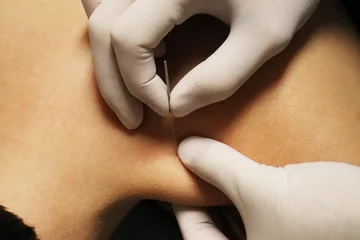Dry Needling
Expertly treating pain in the Fort Lee, NJ area
Dry needling is a treatment that healthcare providers use for pain and movement issues associated with myofascial trigger points. With this technique, a provider inserts thin needles into or near your trigger points. The needles stimulate your muscles, which causes them to contract or twitch. This helps relieve pain and improve your range of motion.

During dry needling, a provider inserts thin, sharp needles through your skin directly into (deep) or near (superficial) your trigger points.
Healthcare providers may use superficial or deep dry-needling techniques.
What is dry needling?
Dry needling is a technique that physical therapists and other trained healthcare providers use to treat musculoskeletal pain and movement issues. It’s almost always used as part of a larger pain management plan that could include exercise, stretching, massage, and other techniques. During this treatment, a provider inserts thin, sharp needles through your skin to treat underlying myofascial trigger points.
In the word “myofascial,” “myo” means muscle. Fascia is the thin, white connective tissue wrapped around your muscles.
Trigger points are knotted, tender areas that develop in your muscles. These trigger points are highly sensitive and can be painful when touched. Sometimes, a trigger point may be near the location of your pain. But they’re also often the cause of referred pain. Referred pain is pain that affects another part of your body.
Ishitani Health Center uses needles to alleviate your trigger points. When dry needling is applied to your muscles and tissues, it can decrease tightness, increase blood flow, and reduce local and referred pain. Providers use solid needles that don’t contain any kind of medication. This is why the technique is called “dry.” Nothing is injected into your body. Trigger point injections are different. They contain medicine and are performed by a physician.
Other names for dry needling are trigger point dry needling and intramuscular stimulation.
How does dry needling work?
When your muscle is overused, it goes into an energy crisis where the muscle fibers aren’t getting an adequate blood supply. When they don’t get the normal blood supply, they don’t get the oxygen and nutrients that will allow your muscle to go back to their normal resting state.
When this happens, the tissue near your trigger point becomes more acidic. Your nerves are sensitized, which makes the area sore and painful.
Stimulating a trigger point with a needle helps draw normal blood supply back to flush out the area and release tension. The prick sensation can also fire off nerve fibers that stimulate your brain to release endorphins, your body’s homemade pain medication.
Once we locates a trigger point, we’ll insert a needle through your skin directly into it. They might move the needle around a little to try to get what’s called a local twitch response — a quick spasm of your muscle. This reaction can be a good sign that your muscle is reacting.
Some people feel improvement in their pain and mobility almost immediately after a dry needling session. For others, it takes more than one session.
Does dry needling hurt?
Trigger points are usually painful to the touch. So, before the needling, you may experience some pain while your provider is locating the trigger point.
You may also feel discomfort during the needling. Sometimes, people don’t feel the needle going in because it’s so small, but other times, people will feel a prick. When the needle is in the trigger point, it can be painful and cause a twitch response. Afterward, you may feel tightness or soreness near the insertion site, but it’s important to keep moving and stretching.
What does dry needling do?
Dry needling may help relieve pain and increase your range of motion. Conditions that dry needling may treat include:
- Joint issues
- Disk issues
- Tendinitis
- Migraine and tension-type headaches
- Jaw and mouth issues, such as temporomandibular joint (TMJ) disorders
- Whiplash
- Repetitive motion disorders, such as carpal tunnel syndrome
- Spinal issues
- Pelvic pain
- Night cramps
- Phantom limb pain
- Postherpetic neuralgia, a complication of shingles
Who shouldn’t get dry needling treatments?
Certain groups of people shouldn’t receive dry needling. Providers don’t recommend the procedure for children under the age of 12 because it can be painful. You and your child will both need to provide consent, and you should consider other less invasive options first. Other groups who should consult with their physician before receiving dry needling include people who:
- Are pregnant
- Aren’t able to understand the treatment
- Are very afraid of needles (trypanophobia)
- Have compromised immune systems
- Have just had surgery
- Are on blood thinners
If you believe you could benefit from high-quality care, consider getting treatment from the staff at Ishitani Health Center. Our dedicated staff will be pleased to answer your questions today. We can also help you schedule a time to visit our Fort Lee office.
Call Us: (201) 302-9993
Email: info@ishitanihealth.com






